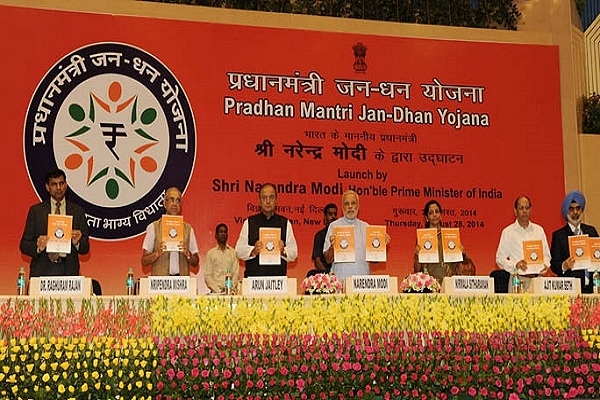Economy
Zero Balances: Modi Must Fix Jan Dhan Credibility Problem Before It Gets Out Of Hand
- As per official figures, only 24 percent of Jan Dhan bank accounts are zero-balance, compared to last year’s nearly half.
- A media investigation revealed that the reduction in zero-balance accounts may have been facilitated as a result of pressures from the finance ministry.
- To reduce zero-balance accounts, the poor need to be educated on how their bank accounts can be used.

Prime Minister Narendra Modi launching Pradhan Mantri Jan Dhan Yojana (Narendra Modi Official (Flickr)/Wikimedia Commons)
The perils of top-down decision-making are nowhere more evident that in Jan Dhan Yojana, Prime Minister Narendra Modi’s speedily-rolled-out banking inclusion scheme. At last count, there were over 24 crore accounts – almost equal to the number of households in India – with deposits of Rs 42,500 crore. Officially, only 24 percent of them are zero-balance when, a year ago, the figures were closer to half.
A recent Indian Express investigation, however, suggests that the sharp fall in zero-balance accounts may have been facilitated by pressure from the finance ministry to reduce these numbers. This resulted in harried bank officials depositing Re 1, or small amounts, to claim that more accounts were now operative. Using information received through Right to Information (RTI), the report said 18 public sector banks and their regional rural banks held 1.05 crore Jan Dhan accounts with deposits of Re 1. Some even held as little balance as 10 paise.
The tragedy is not that there are so many zero-balance accounts, but that a successfully rolled-out financial inclusion scheme is now being sullied by pressures from the top for progress beyond what is naturally possible. This has led to officials trying to game the system with underhand tactics.
There are only two sensible ways to get zero-balance accounts down, and both need to have a long-term perspective.
Since spreading financial literacy is a costly exercise, it would be best if the finance ministry offered separate funding to public sector banks – outside their capital infusion plans – to invest in this exercise. It is not possible for bank officials to develop a high commitment to financial literacy when the other message coming from the top is that they must cut costs and boost profits.
Second, the other part of the exercise must come from the government payments system. If every government payment, including subsidies, NREGA wages, pensions, etc., were to be routed only through a bank account, it should be possible to reduce zero-balance Jan Dhan accounts. This direct credit system needs to be scaled up using the JAM trio – Jan Dhan, Aadhaar and mobile money – that we have heard so much about. With a reasonable time span, say, two years, JAM can be used to reduce zero balances in most Jan Dhan accounts. The spread of payment banking and mobile money will speed up this process, and once again, the need is to improve financial literacy and train the poor on using mobile phones for money transactions.
Pressuring banks to reduce zero-balance accounts without thinking through the last-mile issues in how the poor can use their accounts is counter-productive.
Worse, it can undermine the credibility of a scheme that has so far been a feather in Modi’s cap. He and Arun Jaitley must fix the Jan Dhan credibility problem before it gets out of hand.
Introducing ElectionsHQ + 50 Ground Reports Project
The 2024 elections might seem easy to guess, but there are some important questions that shouldn't be missed.
Do freebies still sway voters? Do people prioritise infrastructure when voting? How will Punjab vote?
The answers to these questions provide great insights into where we, as a country, are headed in the years to come.
Swarajya is starting a project with an aim to do 50 solid ground stories and a smart commentary service on WhatsApp, a one-of-a-kind. We'd love your support during this election season.
Click below to contribute.
Latest